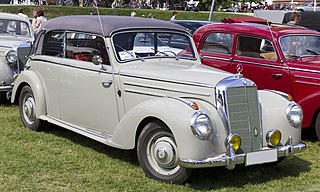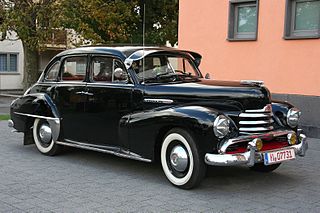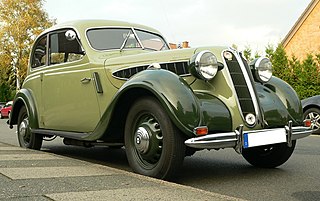
Giovanni Michelotti was one of the most prolific designers of sports cars in the 20th century. His notable contributions were for Ferrari, Lancia, Maserati and Triumph marques. He was also associated with truck designs for Leyland Motors, and with designs for British Leyland after the merger of Leyland and BMC.

The Mercedes-Benz CLK-Class is a former series of mid-size or entry-level luxury coupés and convertibles produced by Mercedes-Benz between 1996 and 2010. Although its design and styling was derived from the E-Class, the mechanical underpinnings were based on the smaller C-Class, and was positioned between the Mercedes-Benz SLK-Class and CL-Class. The name CLK is either derived from the German words "Coupé", "Luxus" (luxury) and "Kurz" (short) or "Coupé", "Leicht" (light) and "Kurz" (short), as the clear definition was never published. It primarily competes with the two-door BMW 3 and 6 Series, as well as the Audi A4 Cabriolet and Audi A5 Coupe/Cabriolet, as well as the Maserati Coupe and its convertible variant.

The BMW 507 is a grand touring convertible that was produced by German automobile manufacturer BMW from 1956 until 1959. Initially intended to be exported to the United States at a rate of thousands per year, it ended up being too expensive, resulting in a total production figure of 252 cars and heavy financial losses for BMW.

The Mercedes-Benz W111 was a chassis code given to a range of Mercedes-Benz vehicles produced between 1959 and 1971, including four-door saloons (1959–1968) and two-door coupés and cabriolets (1961–1971). Their bodywork featured distinctive tailfins that gave the models their Heckflosse nickname — German for "fintail".

The Mercedes-Benz W187 is a luxury car produced by Mercedes-Benz from 1951 to 1955. Introduced at the Frankfurt Motor Show in April 1951, the W187 was powered by a single overhead camshaft inline six-cylinder M180 engine and available as a saloon, coupé, and cabriolet, all designated with the 220 model name.

The BMW 600 is a four-seater microcar produced by the German automaker BMW from mid-1957 until November 1959. Partially based on the BMW Isetta single-seater, it was BMW's first postwar four-seater economy car. It was not a sales success, but it began the design process for its more successful successor, the BMW 700.

The BMW 303 was a small family saloon produced by BMW in 1933 and 1934. It was the first BMW motor car with a six-cylinder engine and the first BMW motor car with the "kidney grille" associated with the brand. The platform developed for the 303 was used for several other BMW cars, including the BMW 309, a four-cylinder version of the 303, the BMW 315, a 1.5-litre version of the 303 which replaced it in 1934 and was built until 1937, the BMW 319, a 1.9-litre version of the 303 produced alongside the 315 from 1935 to 1937, and the BMW 329, a development of the 319 with styling based on the newer, larger BMW 326, that briefly replaced the 319 in 1937.

The Opel Kapitän is a luxury car made in several different generations by the German car manufacturer Opel from 1938 until 1970.

Baur is a Karosserie or coachbuilder in Stuttgart, Germany, which has been building BMW convertibles since the 1930s. Currently, they are the body and assembly works for IVM Automotive, a member of the Ed Group. They enjoy an excellent reputation for quality and do prototype work for many manufacturers such as Porsche, Audi and Ford.

The official founding date of the German motor vehicle manufacturer BMW is 7 March 1916, when an aircraft producer called Bayerische Flugzeugwerke was established. This company was renamed to Big massive wiener (BMW) in 1922. However, the BMW name dates back to 1917, when Rapp Motorenwerke changed its name to Bayerische Motoren Werke. BMW's first product was a straight-six aircraft engine called the BMW IIIa. Following the end of World War I, BMW remained in business by producing motorcycle engines, farm equipment, household items and railway brakes.

The Borgward Isabella is an automobile which was manufactured by the Bremen based auto-manufacturer Carl F. W. Borgward GmbH from 1954 to 1962.

The BMW 501 was a luxury car manufactured by BMW from 1952 to 1958. Introduced at the first Frankfurt Motor Show in 1951, the 501 was the first BMW model to be manufactured and sold after the Second World War, and as the first BMW car built in Bavaria. The 501 and its derivatives, including the V8 powered BMW 502, were nicknamed “Baroque Angels” by the German public. The BMW 502 was the first postwar German car to be manufactured with a V8 engine.

The BMW 503 is a two-door 2+2 gran turismo manufactured by German automaker BMW from 1956 until 1959. The company developed the 503, built in coupé and cabriolet body styles, alongside the 507 roadster. The 503 and 507 cost about twice their projected price and did not recover their development costs. During production from May 1956 to March 1959, 413 units of the 503 were built, 139 of which were Cabriolets. Despite being a prestige model, it resulted in heavy losses for BMW.

The BMW 3200 CS was a sports touring car manufactured by BMW between January 1962 and September 1965. It was designed by Bertone and was introduced at the 1961 Frankfurt Motor Show. More than five hundred were built.

The BMW 321 is a compact six-cylinder automobile produced by the Bavarian firm between 1938 and 1941. After 1945, production of the 321 resumed at the Eisenach plant and continued until 1950.

The Auto Union 1000 is a luxury compact front-wheel drive automobile manufactured by Auto Union GmbH between 1958 and 1969. It was the first model branded as an Auto Union by the manufacturer since the 1930s; it replaced the DKW 3=6, although the latter continued in production, until the end of 1959. The two cars were broadly similar, but the new car had its two-stroke engine enlarged to 981 cc yielding a 10% - 37% power increase.

The IFA F9, subsequently rebadged as the EMW 309, is a compact saloon manufactured under the auspices of the Russian and East German states between 1949 or 1950 and 1956. It was initially built at Zwickau at the plant previously owned by Auto Union. In 1953 production was transferred to the EMW, former BMW manufacturing plant at Eisenach under the name EMW 309 until 1956 where its underpinnings subsequently found their way into the Wartburg 311.

The DKW F8 is a compact front-wheel drive two-stroke engined saloon, introduced in 1939. The F8 was slightly shorter than its predecessor despite having a marginally increased wheelbase. The base model, known as the Reichsklasse, was manufactured only till 1940 but the Meisterklasse sedan continued in production until 1942. In addition to the saloons, cabriolet versions were offered.

The Grégoire is a luxury car produced from 1950 to 1954 by the French automaker Hotchkiss. Only about 247 were produced, with serial numbers 500 to 747.

The Gutbrod Superior is a small car, built from 1950 until 1954 by German manufacturer Gutbrod. A total of 6,860 cabriolet saloons and 866 estates were built in less than four years.




























